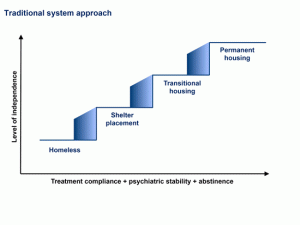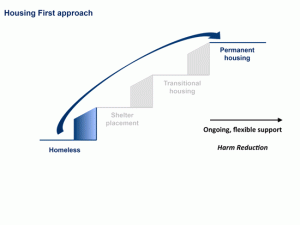There are homeless people in our midst, all across our land. People without a home of their own. And, among these homeless people, there are some who are “chronically homeless – in other words, they will be homeless if the “rest of us” do not do something to help them. And the best help we can offer is this simple – they need a home first! And, it’s not about “managing” homelessness – it’s about “ending” homelessness. This book proposes the now-proven approach of “a house – a house first!”
——————
On Monday of this week, I presented my synopsis of Housing First: Ending Homelessness, Transforming Systems, and Changing Lives by Deborah Padgett, Benjamin Henwood, Sam Tsemberis, at a session sponsored by the Metro Dallas Homeless Alliance (MDHA), CitySquare, and the Dallas Public Library. I spoke, and then Larry James of CitySquare, Cindy Crain of the MDHA, along with Edd Eason of CitySquare, spoke and responded to questions from the audience. Click here to watch the video of the entire presentation and discussion).
Housing First, the idea, was developed in 1992, with the work of one of of the authors of the book. From the book:
In 1992, Housing First was developed as a new program by psychologist Dr. Sam Tsemberis, who founded Pathways to Housing, Inc.
I began with this: Why is this book worth our time?
#1 – We do have homeless people. What shall we (our city; our community; you and I!) do as we think about homeless people in our community?
#2 – Should we do what works, or what we think should work, or wish would work? This book helps us know what actually works.
#3 – And, this book is a book about: change management, paradigm shifts, and of course, social justice. In other words, there is something in this book for all of us.
This paragraph from the book captured the essence of the issue:
The scatter-site supported housing model met consumers’ requirements for normal housing (“We just want a simple ordinary apartment.”), tenancy rights (“a place that is mine”), privacy (“I can wake up when I want.”), freedom separate from program demands (“I don’t want to have to hide my beer under the couch when you come to visit.”), off-site rather than on-site services (“I may want to go to treatment but I don’t want to be living in treatment.”), and affordable rent contributions (30% of income).
Housing First, the approach, has now spread throughout the country, and into other parts of the world. The idea is this: the old model was to get people clean and functioning, thus “housing deserving and housing ready.” The new model follows this premise: people will get into a more functional life if they receive a house first! From the book:
In Bristol, Tennessee, deep in the heart of Appalachia, the director of a homeless program for veterans states, “We follow the ‘housing first’ model. We house them first and then you look at all the other services they need to keep them in housing.”
and
Study after study shows that 80% to 90% of Housing First participants are successfully maintaining their housing.
So, who are the homeless? From my handout (from the book):
• the “short-term” homeless (about 4000 in Dallas)
• the “chronically homeless” (about 615 in Dallas) – most often:
• struggling with addiction
• suffering from mental illness
• started out in poverty
• predominantly African-American
• younger; 18-24 – or above age 50
• and, for this book/this approach – predominantly “single” – (the research is just beginning on this approach for families)
 The long-practiced model has been primarily the staircase model:
The long-practiced model has been primarily the staircase model:
What did such organizations look like? The bigger ones might have the staircase fully represented: drop-in center, emergency shelter, community residence (an entire building or portion of a building dedicated to congregate living for clients), scattered apartments where clients live two or three per unit, and single occupancy apartments (the ultimate step). Clients might enter at the bottom and work their way up or, if deemed higher functioning at the time of referral, enter at a higher step (only Housing First gave access to the highest step right away).
And this is the new model: From “treatment first’ to “housing first” – Housing comes first!
- treatment first – “first they have to be housing ready, and/or housing deserving”
- moving from “transitional housing” to “permanent housing” – living among us all
- Moving from “let’s get the homeless out of our sight” to “let’s help them live among us (in “scatter-site housing”)
• Here are the critical elements of the Housing First model — remember, Housing is First!:
#1 – consumer choice
#2 – community based, mobile support services
#3 – permanent scatter-site housing
#4 – harm reduction
• And here are my lessons and takeaways:
#1 – To end homelessness, let’s become very open to learn about, pursue, and embrace what actually works
#2 – To end homelessness, let’s get on the “we can end homelessness” train.
#3 – To end homelessness, let’s decide we can live with and support “harm reduction”
#4 – To end homelessness, let’s embrace “Housing First”
There was, of course, much more. The book prominently features the New Yorker essay by Malcolm Gladwell , Million Dollar Murray. Murray Barr, a beloved homeless man in Nevada, ended up accumulating over 1 million dollars in pubic service costs (e.g., emergency rooms; nights in jail) over a ten year period. This would have been greatly reduced if he had had a house of his own. In other words, housing first is not only more human and humane, it is also cost-saving. From the article:
“It cost us one million dollars not to do something about Murray.”
People have talked a lot about the homeless “problem,” in Dallas, and pretty much everywhere else. This book, Housing First, belongs near the top of everyone’s reading list if they truly care about the people who are struggling with the most basic of human needs – the need for a home.
